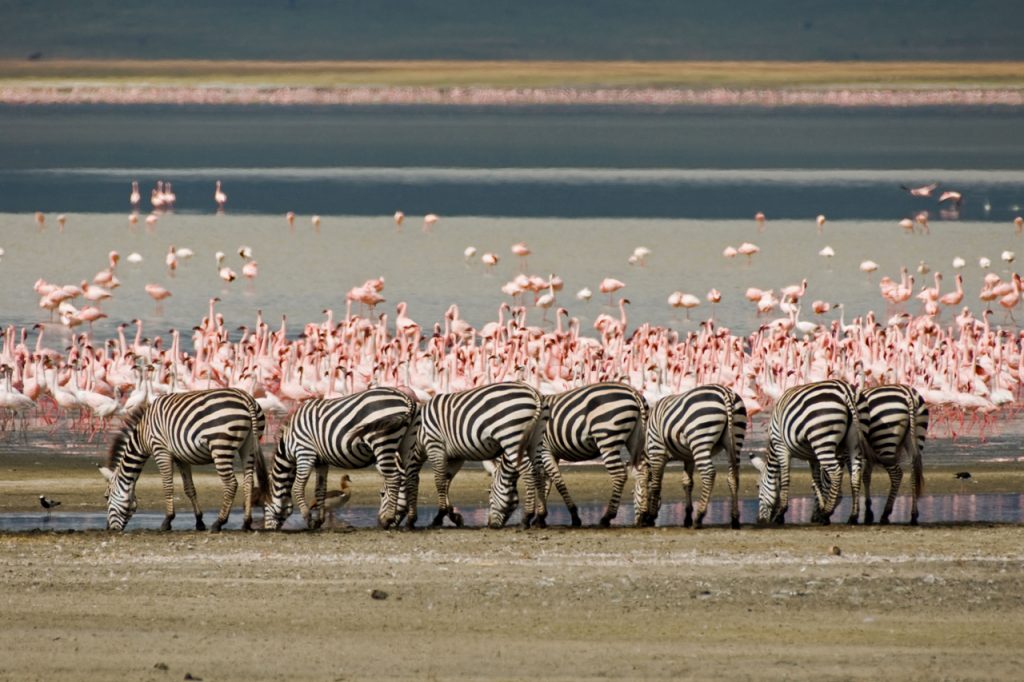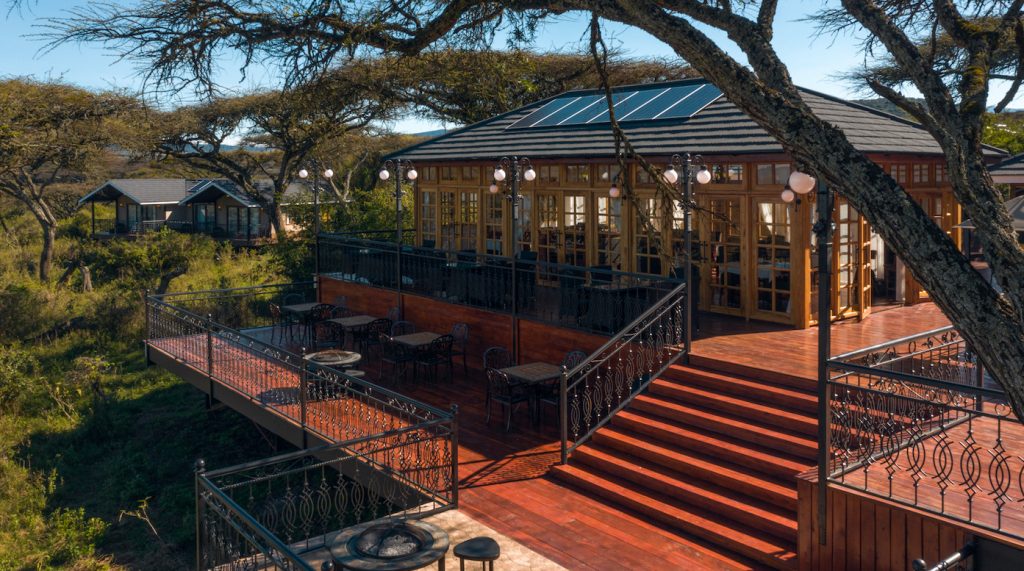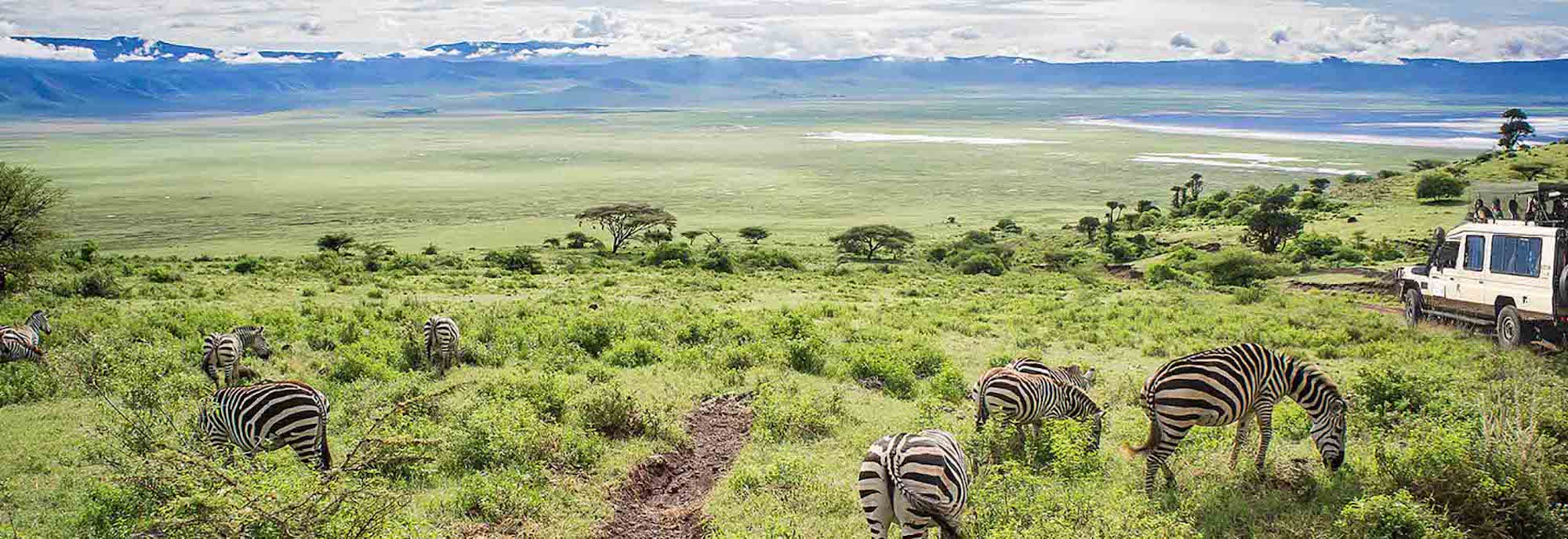Ngorongoro Crater Located around 160 kilometers from Arusha, the larger Ngorongoro Conservation area is characterized by highlands, and plains but the real jewel of there is the Ngorongoro Crater.
Geographically what has all the way been famously known as the Ngorongoro Crater; is the largest unbroken caldera in the world. Ngorongoro Crater as a safari destination features in most of our Tanzania safari tours that can be customized in anyway in order to suit your needs, ideas and budget.
With a diameter of about 20 kilometers, 600 meters deep, and around 300 meters square kilometers in area, the Ngorongoro crater is a world heritage site under the UNESCO, and allows Multiple land use unlike the national parks. The Maasai nomadic people are allowed to graze cattle in the area and with their culture and traditions they have managed to live harmoniously with the wild animals without causing any major conflict.
Please check out some of the famous Tanzania lodge safaris that we can customize for you in anyway in order to suit your needs and ideas any time!

At the center of the Ngorongoro Crater that has now been dubbed the Eden of Africa or the eighth wonder of the world; is the Lake Makat. This soda lake that is fed by the surrounding highlands ensures a constant supply of water all year round that in turn makes the concentration of animals in this natural marvel incomparable to no other area in east Africa. No other place you can see animals at such close range and with just a little bit of luck, one can spot the BIG 5 in one day of game drives alone.
The Lerai Forest at the Ngorongoro Crater’s floor is habitat for the shy leopard, and provides shade for the elephants. This forest is also a favorite spot for the troops of baboons and monkeys. Other animals that can be easily viewed includes the topis, elands, wildebeests, zebras, hippos, buffaloes, cats like serval cats, cheetahs, and lions, a lot of hyenas that can be see cooling in the afternoons at the lakes and pools.
Ngorongoro crater Tanzania
Bird life is also amazing inside the crater, with aquatic birds like flamingos cormorants, Egyptian geese, ibises among others. Other birds include hammer kops, weavers, starlings and many more.
The management of the Ngorongoro Conservation Area does not allow camping, and walking inside the Crater, and game drives visitors should leave the Crater floor before dusk.
The Ngorongoro Crater can be included in a long, short safaris and can also be done as a day trip from Arusha town.
Please let us know if you would like us to include the Ngorongoro Crater to your safari program. See our 3 days Safari to Ngorongoro Crater in Tanzania.
Access to Ngorongoro Safari
The Ngorongoro crater and the entire Ngorongoro Conservation Area at large (NCAA) is generally an easily accessible destination.
One can easily take a road trip to The Ngorongoro Conservation Area which is a nice scenic 3 hour drive from Arusha, 41/2 hours from Moshi town. The drive is normally done in our 4×4 safari land cruisers. Your private Tanzania Safari Supremacy guide will pick you up from Arusha and drive you to Ngorongoro Crater where he will guide you at the floor of the Ngorongoro Crater or at Ndutu Plains, or while hiking at the Empakaai Crater depending on your program.
Apart from going to Ngorongoro by road, there are several flight companies that operate scheduled flights to the Ngorongoro Crater Rim where there airstrip is located. Flights do not fly into the floor of the Ngorongoro Crater because here is no airstrip at the floor of the Crater. Flights to Ngorongoro can start from Arusha town, Kilimanjaro International Airport, Zanzibar, or Dar es Salaam but may include a few stops on the way.
It is also possible to fly into the Lake Manyara airstrip, located at the top of the Rift Valley Escarpment from where you can be picked up by our safari guides and driven by road a short 30 minutes’ drive to the gate (1 hour to the Crater’s floor). Our safari experts can always pick you up from Lake Manyara Airstrip and drive you to the Ngorongoro Crater where you will proceed with your safari activities.
Where to stay at Ngorongoro Crater
Ngorongoro Conservation Area has a number of accommodation within the Ngorongoro Conservation area but they are few and cannot cater for everyone. Out of that need of more rooms, many lodges have been set up at Karatu in the Ngorongoro Highlands; just a few minutes from the Loduare Gate (main gate). The few lodges that are located inside the NCAA are mostly Standard luxury lodges and tented camps all the way up to high end / top market lodges. Only one midrange lodge is located inside the Ngorongoro Conservation Area; Rhino Lodge.
The collection of lodges and tented camps perched on the Crater rim have great views overlooking the Crater’s floor but quality of views differ from one lodge to another. The lodges and camps that are also located at the Crater rim have easy access to the Crater floor and that means you will be among the first t get to the Crater floor in the morning if you don’t mind waking up early. The prices for staying at the lodge is usually high because they are few inside but also the prices include concession fees that is charged to lodges that are located inside parks. These lodges located inside are usually large in size so if you are looking for a small place to stay then it is not the best place for you.
Among them, the Ngorongoro Crater Lodge is the most expensive and the most luxurious lodge inside the NCAA. Other lodge options that have views over the floor of the Ngorongoro Crater include; Ngorongoro Sopa Lodge at the eastern side of the Crater rim ( with great sunset), Ngorongoro Serena Safari Lodge on the western rim and the Ngorongoro Wildlife Lodge. Others that also located inside the NCAA include the Highlands Ngorongoro (Deluxe lodge), the Lemala Ngorongoro Camp, and the new but gorgeous Lion’s Paw Camp by the Karibu Camps.

For the lodges that are located at Karatu nearby the luxurious options include the Gibb’s Farm, Manor at Ngorongoro, Neptune Ngorongoro Luxury Camp. Other standard lodges include the Ngorongoro Coffee Lodge, Plantation Lodge, Oldeani Mountain Lodge, Plantation Lodge, Kitela Lodge and the Acacia Farm Lodge. Midrange lodges include Ngorongoro Farm House, Marera Valley Lodge, Country Lodge, Bougainvillea Safari Lodge and Pamoja Olea Farm Lodge.
Our Tanzania safari experts can always advise you on the best lodges camps to stay in within and outside the Ngorongoro Conservation area depending on your budget and preference.
The Ngorongoro Crater is one of the ‘must see’ bucket list destinations in Tanzania, the reason why it is included in most of our Northern Tanzania safari itineraries.
One of them is our 10 Days Kenya and Tanzania safari tour, that includes Serengeti National Park, Ngorongoro, Masai Mara and Amboseli National Park in Kenya.
Empakaai Crater – Ngorongoro Conservation Area
The Empakaai Crater is a much smaller caldera but extremely beautiful with a Crater lake at the Crater floor. The Empakaai is located about one and a half hour’s drive from the Ngorongoro Crater.
The deep soda lake at the floor of the Crater covers around half of the 6 Kilometer caldera. During your visit you expect to see thousands of flamingos in the edges of the Crater lake because the areas are the shallow parts of the lake, giving the lake’s shores a specular pink tinge. To get to this place you will be driven in a 4×4 safari land cruiser to the outer rims of the Crater, followed by a 45 minutes hike down the Crater, as your guided by a trained armed ranger who will come with a rifle to ensure your safety.
From the Empakaai Crater you will be treated to one of the greatest views you have ever seen. The view you get from Empakaai down to the Lake Natron and the Mount Oldoinyo Lengai from far is arguably one of the best in the whole of Africa. If you are lucky to have visited here on a lucky day you may even spot the Mount Kilimanjaro and the Lake Natron from here. We can include for you a visit to Empakaai Crater if you have at least two days to visit the Ngorongoro Highlands and the Crater.
Olduvai Gorge – Ngorongoro Conservation Area
Part from wildlife the The Ngorongoro Conservation Area generates interest based on other things one of them geology and archeology. One of the most important prehistoric sites in the world is found here in the name of Olduvai Gorge. Fossils of the hominid Australopithecus Boisei (Zinjanthropus) also known as the Nutcracker man was discovered here and the fossils are said to have dated back to 1.4 million years ago. The discovery was made by a renowned and archaeologist; Louis Leakey and his wife Mary Leakey.
The 48 kilometer long Olduvai Gorge is a steep-sided ravine in the Great Rift Valley that runs through this part of Tanzania.
There is a museum on this site with a stock of replicas of the hominid fossils that were unearthed at this site. Apart from the Olduvai Gorge you may also be interested in visiting the Laetoli Footprints which is the most ancient footprints that have ever been found in the world.
Animals in Ngorongoro Crater
Ngorongoro Crater is believed to have the highest concentration of wildlife in a natural habitat in the whole world ( animal / per area ratio).
The special animal species of the Ngorongoro crater is obviously the black rhino!. The Rhinos are a rare species and very hard to spot in Tanzania if you are looking for an opportunity to spot them in their natural habitat. The animals usually like to stick to thick vegetation so they can be extremely hard to spot.
It is however different in the Ngorongoro Crater. They have a habit of spending the nights in the Lerai Forest located at the floor of the Ngorongoro Crater so your guide will help you in trying to spot the Black Rhino and hopefully all the Big Five which reside in the Crater; Lions, Elephants, Buffalos, Leopards and the Rhinos. Apart from the black rhinos other rare species like the golden jackal and black backed jackals as well as spotted hyenas which are in abundance at the Crater floor.
Other commonly spotted wildlife in the Ngorongoro Crater include; hippos, buffalo, zebra, wildebeests, elephants, lions, hartebeests, warthogs, and many other animal species as well as many birds species.
Best Time for Wildlife viewing in Ngorongoro Crater
Ngorongoro Crater is one of the wildlife areas where wildlife viewing is excellent at the Crater floor throughout the year.
During the wet season the Ngorongoro Crater’s scenery is at the best, ideally between the months of November and May. The grasses however might be tall during this time and that may interfere with animal spotting especially the smaller species. Usually the months of March to April are the wettest months not only at Ngorongoro but throughout East Africa.
The best time to visit Ngorongoro is June to September when the wildlife game drives are at their best due to shorter grasses and therefore better visibility. July to March is Ngorongoro Crater’s high season and therefore during that time you will encounter crowds at Ngorongoro if you are visiting at that time.
The best weather is experienced during the drier months between June and October while the worst weather is during the long rains season of March and April. Check out a few of our Tanzania safari tours and packages that include a visit to the Ngorongoro Crater!

